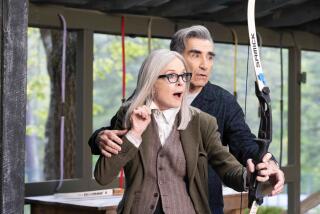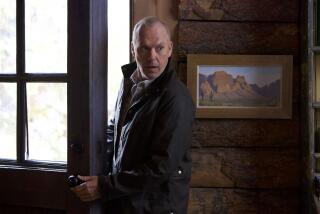From the Archives: Films’ Buster Keaton Dies of Cancer at 70
- Share via
Comedian Buster Keaton, 70, Hollywood immortal whose trade-mark was the dead pan and who felt last year that “I might live forever,” died of lung cancer Tuesday in his Woodland Hills home.
Keaton’s anticipation of longevity was expressed in a moment of exuberance over the latest flowering of his fabulous career, begun in a Kansas tent show at the age of one day.
“I have so many projects coming up, I haven’t time to think about kicking the bucket,” he exulted. People are always telling me I’m immortal, and I just might prove them right!”
Up and Down Life
Three months ago he was stricken. His wife of 25 years, Eleanor Norris Keaton, was at his side when he died. A sizable segment of Hollywood’s past and of theatrical history died with him.
In addition to his widow, he leaves two sons, Robert and James Talmadge of Santa Monica, who took their mother’s name when Natalie Talmadge, Keaton’s first wife, divorced him in 1932.
He also leaves a brother, Harry, of San Ysidro, and a sister, Miss Louise Keaton of Los Angeles.
Funeral services will be conducted in the Church of the Hills at 1:30 p.m. Friday and will be followed by interment in Forest Lawn Memorial-Park, Hollywood Hills.
Scaled Heights
Keaton scaled both the heights and the depths. He came to Hollywood from the vaudeville stage in 1917, a consummate acrobat with an exquisite sense of comedy timing and an expressionless frozen face that “rolled ‘em in the aisles.”
He ranked with Harold Lloyd, Charlie Chaplin and W.C. Fields as a comedy king. He became the husband of Miss Talmadge, one of the three famous sisters who were reigning feminine stars.
He became world-famous, made millions and owned a $300,000 Beverly Hills estate with its own trout stream and game bird preserve.
He sailed the seas in a $120,000 yacht and the United States in a “land yacht” which he owned with actor Lew Cody. Tales of his escapades in the gaudy 1920s are Hollywood legends.
“We used to have weekend poker parties where a man would win or lose $50,000 in an evening and either way didn’t worry about it,” he recalled. “He could always make another picture.”
Then came the advent of talking films and what appeared to be the end of it all. Keaton’s silent pantomiming failed to conform with the mode. Hollywood no longer beat at his door.
In 1932 he and Miss Talmadge were divorced after 11 years of marriage. In 1934 he was forced to go through bankruptcy.
But Keaton was never entirely idle. He became a play doctor, a gagman, a coach for young comedians—Red Skelton, to name just one. In 1937 MGM hired him as a director of short subjects.
Then it all began to come back. In 1933, Keaton had married a nurse, Mrs. Jewel Mae Keaton, but they were divorced two years later. In 1940, however, he married the dancer, Eleanor Norris, and they lived happily ever after.
Keaton’s brand of comedy was “discovered” once more. Film parts began to come his way. Television arrived, and producers of TV commercials were amazed to find that his pantomime was as “killing” as it always been.
Stoicism Expressed
Keaton regarded change happily, but with stoicism.
“Comedy does not change,” he observed in an interview a few months ago. “Here’s the best proof in the world:
“Two years ago we sent a picture to Munich, Germany, using old-fashioned subtitles with a written score. This was ‘The General.’ It was made in 1926, and hell, that’s 39 years ago.
But I sneaked into the theater and the laughs were exactly the same as on the day it was first released.”
The world of Buster Keaton began in Piqua, Kan., on Oct 4, 1895, where his parents, Joseph and Myra Keaton, vaudeville acrobats, were playing a one-night stand in a medicine show with Harry Houdini, later the famous escape artist.
His First Applause
He liked to recall that when he was one day old his father carried him on-stage and drew a round of applause. By the time he was able to walk he was one of the “Three Keatons” act.
Young Keaton was christened Joseph Francis, after his father, but from his second or third year he was called nothing but Buster.
Houdini gave him the name by exclaiming, when he saw the baby tumble down a stair and scramble to his feet unhurt, “Isn’t he a buster!”
Keaton had need to be a Buster, for the Three Keatons’ act was strenuous. Between acrobatic feats they interspersed comedy routines, and Buster normally made his entrance with his father carrying him by the seat of the pants.
Lesson From Mother
Buster’s first lessons in the comedy of contrast probably were given him by his mother who, while her husband was literally wiping the floor with the boy, stood downstage playing a saxophone, oblivious even when her dress was torn off in the stage scuffling.
Later, when Buster grew to his full 5 feet, 5 inches and 140 lbs., he was too big for his father to toss around. The routine called for them to trade swats with brooms, and Buster discovered the “double-take.”
After a particularly resounding swat, he would stare vacantly for a long moment, then remark in conversational tones, “Ouch.”
Few legitimate and no movie audiences paused to consider that Keaton’s comical duck walk and the bone-rattling falls he took with impunity were the product of a lithe grace and acrobatic skill.
But Buster’s juvenile talents weren’t limited to acrobatics. One season he played “Little Lord Fauntleroy” in flowing curls, and another stole bows from the great English actress, Lily Langtry.
Miss Langtry was playing on the same vaudeville program as the Keatons, and the audience loved to see the child walk on-stage when she was making a curtain call and gravely take the bow intended for her.
Buster was playing the Pantages Theater in Oakland just before America’s entry in World War I when Roscoe (Fatty) Arbuckle took him to Hollywood with an offer of $40 a week to appear in some comedies.
Sergeant During War
With the outbreak of the war Keaton enlisted, serving in the Rainbow Division with the final grade of sergeant, but he was back in Hollywood as soon as hostilities ended.
Almost immediately he became a two-reel comedy favorite along with Charlie Chaplin, Harold Lloyd, Charlie Chase, Harry Langdon and Ben Turpin.
The titles of his pictures are too many to remember, “The Passionate Plumber,” “Sherlock Jr.,” “Go West,” “Free and Easy,” “The Cameraman.” “Parlor, Bedroom and Bath” . . .
One of the best-remembered Keaton sequences occurs in “The Navigator,” in which Keaton, dressed in a ridiculous admiral’s uniform rides a new ship down the launching ways.
Only One Smile
Predictably, the ship slides slowly under water with Keaton just as slowly vanishing—without change of expression—until only his ultra-thin porkpie hat floats on the surface.
“I did smile, once,” Keaton used to confess, “in a fadeout where I was supposed to get the girl.” We thought the audience would say. ‘Oh goodie, he finally smiled,’ but do you know what?
“The preview audience only said, ‘Look, the bum’s laughing.’ We had to cut it out.”
From the Archives: Face of Great Actress Subtle Even in Death
From the Archives: Magician, Harry Houdini, Succumbs
From the Archives: Veteran Actor Vincent Price Dies at 82
From the Archives: Aimee Semple McPherson Dies Suddenly in Oakland
More to Read
Start your day right
Sign up for Essential California for the L.A. Times biggest news, features and recommendations in your inbox six days a week.
You may occasionally receive promotional content from the Los Angeles Times.






